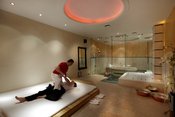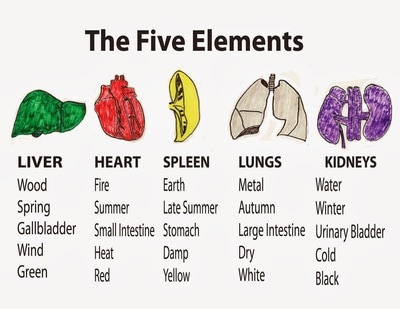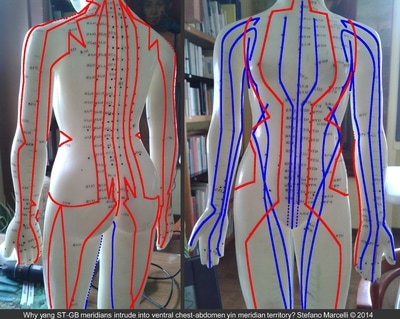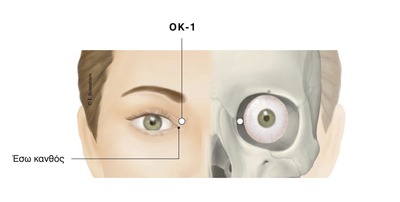Zen Shiatsu
The Japanese way of Acupuncture without needles
Part 2:
The Elements Yin & Yang, The 5 Elements,
The Meridians – What is tsubo? The Kyo/Jitsu concept

It is the oldest (700 BC) and significant philosophical theory in Chinese medicine, which is completely different from any Western. Therefore, according to this theory, everything in life, every phenomenon can be exactly what it is, and also it’ s opposite. Also, the Yin element contains within it the seed of Yang and the Yang Element contains within it the seed of Yin Element.
Each element complements and supports each other. They are two phases in a circular
motion. For example, the day alternates to night progressively, there is time of day that
contains little dark and there is time of night that contains light in it.
Like the Five Elements, so Yin-Yang have some specific characteristics, qualities,
properties. Some of them are Light-Dark, Motion-Rest, Material and Intangible, Energy-
Matter, Water-Fire, etc.
Yin-Yang keeps under it’s power and control some internal organs. Between them there
are some principles of co-existence and relationship, which when they are violated a
disharmony and imbalance is occurred to human organs and body.

This is an ancient Theory (1000 -770 BC), that together with the Yin-Yang theory they
are the basis of Traditional Chinese Medicine. The term has been used by ancient Greek
philosophers, Air-Fire-Earth-Water, roots, elements, primordial bodies, etc.
In fact, it is about five processes, five qualities, five stages of a cycle or alternating phenomena. The 5 Elements are Wood, Fire, Earth, Metal and Water.
Each element has specific characteristics, qualities, properties that in Shiatsu practice are used in Physiology, in Pathology, in the diagnosis and recovery strategy that we will
pursue.
Some of these are the flavors, sounds, odors, some senses, climates, etc. Each item is
under the influence of an internal vital organ such as the Liver, Heart, Spleen, Large Intestine, Kidney, Gall Blader, etc. Each organ influences, governs, controls, affects another and is controlled and affected by someone else. There is a regular balanced Cycle of Control of all previous procedures, but there is also an Imbalanced cycle and one Insulting Cycle.
As is mentioned above, the therapist who uses T.C.M, the Acupuncturist or the Shiatsu
therapist is called to restore this Disharmony and to restore it to its original equilibrium
(state).

According to Chinese Medicine, energy is released in some channels on the surface of
our body. The Meridians are the pathways for the circulation of Chi and present in everyone's body. 12 Meridians have been identified and every one of them takes its name from the specified internal organ passes through or is connected e.g Heart Meridian, Stomach Meridian, Bladder Channel, etc
Over the Channels there are specific points, on which the Shiatsu practioner puts
pressure or the acupuncturists needles. The points are numerous and located on or near veins, arteries, tendons, nerves. And no, I am afraid they are not the points of the
lymphatic system, as some health professionals claim, rationalizing the system of
Traditional Chinese Medicine with Western mindset of conventional medicine!
The points in Japanese are called Tsubo and these in turn have names. In Chinese, for some of the points are used somewhat poetic names such as "Gate of Life / Mingmen", for some others quite illustrative names as "Intersection of 3 Yin / Sanyinjiao". In English we use the name of the Channel belonging point numbered, such as Du -4 and Spleen-6 respectively for the previous two.
Each point has specific functions, techniques by which is pressed, actions that it does, and some times contraindications. So, one point can strengthen an internal organ or Yin or Yang and other point can calm or descent the Chi. Some enhance the (birth) delivery, so if you do not want to have unexpected results, do not press it! A well, efficiently and
professionally educated therapist of Shiatsu, in order to identify the points should
certainly have learned first Anatomy, Physiology and Pathology and point location!

In the system of Zen Shiatsu, whose founder was the Japanese teacher of Shiatsu Shizuto Masunaga (1925-1981), there are the concepts Kyo / Jitsu. They have been translated as Empty / Full, ie deficient and excess Chi respectively, referring to a tsubo point.
The Jitsu / Full points are easily identifiable by touch (and by the kin eye sometimes), as they would usually are protruding and aching, eg in a back. The Kyo / Empty points are identified with difficulty and usually they are deeper in the body. The Shiatsu therapist should have enough experience to distinguish the difference, and to turn them into their original balance effectively. This is the difference of a good shiatsu session with a very good session Shiatsu!
The teacher of Zen Shiatsu, Chris Jarmey, whose courses I had the fortune and honor to attend many times, in his book – ‘Shiatsu, The complete guide’ (with G. Mojey and my greek teacher Ilaira Bouratinou), likens the Kyo / Jitsu like a house which someone is banging the door. Depending i.e. if someone is inside the house and not or someone can be inside but does not wishes any visitors or the opposite, someone welcomes you and shows you he was expecting you to knock the door!
books from my study years:
• The Foundations of Chinese Medicine, Giovanni Maciocia
• Acupressure for common ailments, Chris Jarmey & John Tindall
• Shiatsu, The complete guide, Chris Jarmie & Gabriel Mojay & Ilaira Bouratinou
• A practical Guide to Acu-points, Chris Jarmey & Ilaira Bouratinou
• Meridian Exercises, The Oriental way to health and vitality, Shizuto Masunaga
• Taiji Qigong, Chris Jarmey
• Personal notes and client files from my professional experience up today

I have studied Marketing and Business Administration (B.Sc) at I.C.B.S college in Thessaloniki Campus and Zen Shiatsu and various massages at the European Shiatsu School Athens.
Recently I have completed the certified training program of "Professional Education & Training of Trainers" and the certified program "Marketing Mix and Business Development" of National Kapodistrian University of Athens continuous education programs. I am from Thessaloniki, N. Greece, I live and work in Santorini, Greece.
I operate mainly in the hotel spa business, dedicated to special professional education and information, planning and management of spas, co-working only with clients and people who share the same Vision, Principals, passion and Organizational Culture with me.
If you wish to contact me, please visit www.santorinizenspa.com or email me at [email protected]












 RSS Feed
RSS Feed

